Product Development Process: Objectives, Challenges and Solutions

The new product development process is a structured approach to creating a new software product from idea to launch. It is designed to help organizations develop software products that meet the needs and expectations of their target audience. In this article we will cover 7 stages in the new product development process, challenges you may face at every of them and tips on how to deal with them.
If you ask Google or ChatGPT “what is product development process” you will get the answer similar to the one we gave in the first abstract — purely technical, taking you nowhere. We have been in this business over two decades, and our goal is to show you how it works for real. It is a long article, so here is an outline for easier navigation:
Recent Changes in the New Product Development Process
They have been developing software when we just started in 2001, they have been also doing it 20 and 40 years before that. New software product development has undergone significant changes in recent years due to advances in technology and changes in market conditions. Here are the changes we’ve tracked and trends we believe will hold:
- Increased use of agile development methodologies: Agile development methodologies, which involve iterative development and rapid prototyping, allow for more flexibility and adaptability in the development process, which can be helpful in rapidly changing market conditions.
- Greater emphasis on user experience: There has been an increased focus on user experience in recent years, and this has led to a greater emphasis on developing software that is easy to use and intuitive. This includes gathering and analyzing data on user needs and preferences to inform design decisions. It is not about what you want to do, it is about what they want
- Increased use of cloud computing: The use of cloud computing has had a significant impact on software development. Cloud computing allows for more flexible and scalable software development, as well as easier access to data and resources.
- Greater emphasis on security: The importance of cybersecurity has strengthened exponentially, and has led to a greater emphasis on developing software that is secure and protects user data.
- Increased use of artificial intelligence: AI allows for the development of more intelligent and sophisticated software applications, which can provide greater value to users
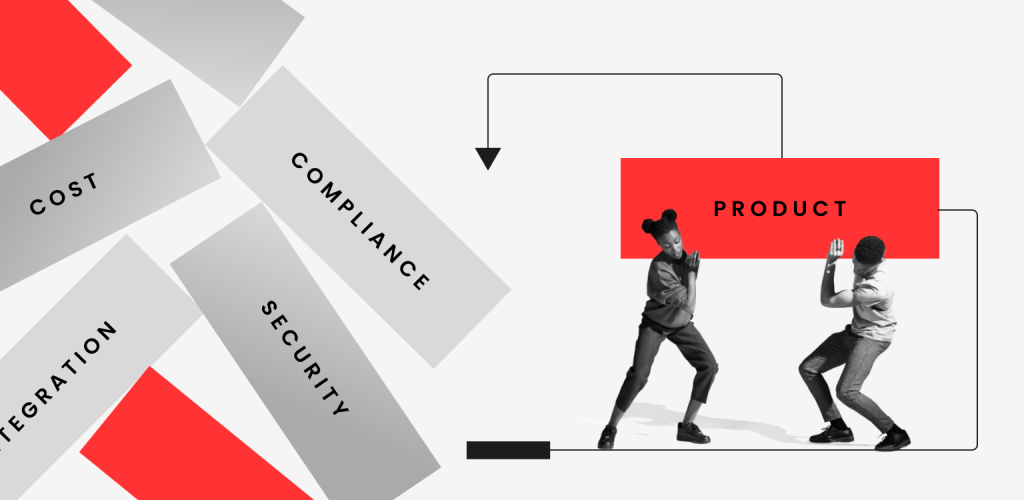
Why is it important? Following these trend may cost money, and not following them may cut your chances to succeed in half. It means you need to plan thoroughly and choose employees, partners and outsourcing companies that have experience in new product development with the usage of the features and methodologies mentioned above.
For example, you’ve decided to use cloud computing to make your product more user-friendly. You face at least four major problems immediately:
- Security. Organizations must ensure that their data is secure when it is stored in the cloud and that their applications are protected from unauthorized access or attacks.
- Compliance. Use of the cloud should comply with relevant laws and regulations, such as data privacy laws and industry-specific regulations.
- Integration. Integrating cloud computing with on-premises systems and processes can be a challenge as it involves updating existing systems and processes to work with the cloud, or integrating cloud-based tools with existing tools and systems.
- Cost. You must carefully evaluate the costs and benefits of using the cloud in order to determine whether it is a cost-effective solution for their needs, or it is better to choose on-premises solutions.
We are well-versed in dealing with this kind of challenges and will show you which solutions you can rely on at every stage of product development process.
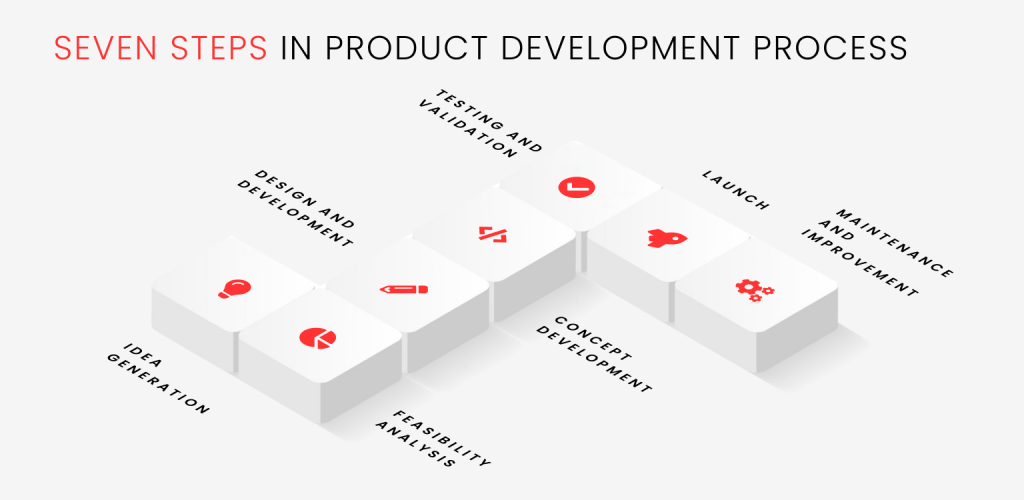
Seven Steps In Product Development Process
We won’t reinvent a wheel here. This list will be just the same as in 90% of other articles elaborating on “what are the steps in the new product development process” topic. Here is what you get as a product owner or an outsourcing company, joining from the very beginning:
Step #1. Idea generation. Ideas for new products are generated and hand-picked through brainstorming sessions, customer feedback, market research, and other methods;
Step #2. Feasibility analysis. In this stage, the ideas are evaluated to determine whether they are technically and economically feasible. This includes analyzing the market demand for the product, the cost of production, and some of the potential risks or challenges that may arise.
Step #3. Concept development. Once an idea has been deemed as potentially possible to realize, it is further developed into a detailed concept. This includes defining the features, benefits, and target market for the product, as well as creating prototypes or mock-ups to test the concept.
Stage #4. Design and development. The product is designed and developed based on the concept that was created in the previous stage. This may include prototyping, and preliminary testing to ensure that the product meets necessary specifications and requirements.
Stage #5. Testing and validation. Before the product is released to the market, it is thoroughly tested to ensure that it is functional, safe, and meets all quality standards. This may involve testing the product in a variety of real-world scenarios to ensure that it performs as expected.
Stage #6. Launch. Once the product has been successfully tested and validated, it is ready to be launched to the market. This may involve creating a marketing plan, setting up distribution channels, and other activities to ensure that the product is introduced to the market in a way that maximizes its chances of success.
Stage #7. Maintenance and improvement. Even after the product is launched, the product development process does not end. That is why depicting the product development process as a straight line is a mistake. It is not a line, it is a rising spiral. The product may need to be maintained and improved over time to ensure that it continues to meet the needs of the market and customers.

“One of the biggest risks in product development is understanding the problem that the product is trying to solve. For example, suppose the product is designed to solve a symptom rather than the root cause of a problem. In that case, it is likely to be less effective and may ultimately fail. It’s important for product managers to thoroughly research and understand the needs of the target market and to design a product that addresses those needs effectively.”,
Vignaraj Gadvi, Senior Product Manager at Better.
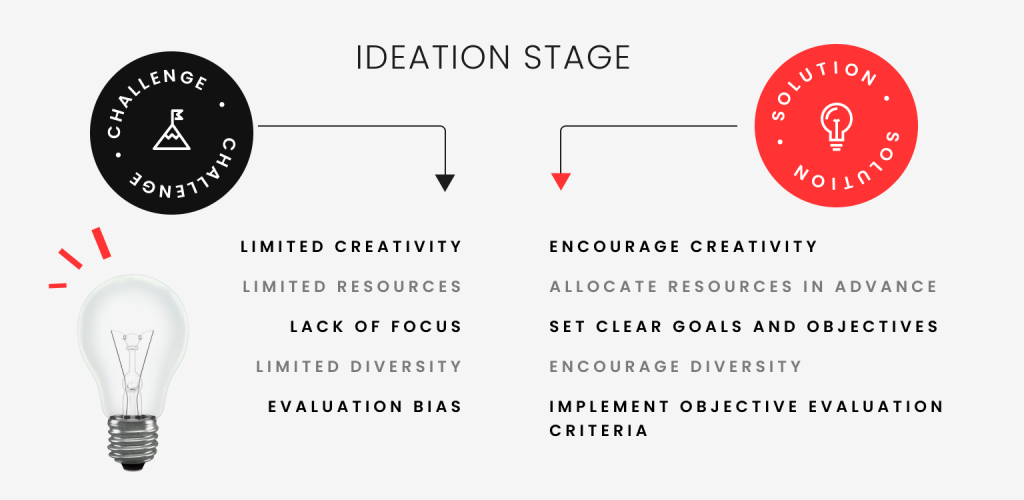
1. Ideation Stage
This stage sets the direction for the rest of the product development process and helps to ensure that the product that is eventually developed meets the needs and desires of the target market.
Key Components
- Brainstorming. A group of people come together to generate ideas through a series of open-ended discussions and exercises. The goal is to generate as many ideas as possible, without evaluating or criticizing them at this stage.
- Customer feedback. Gathering input and feedback from potential customers through surveys, focus groups, or other methods to gather insights into what customers are looking for in a product.
- Market research: Conducting market research can help to identify trends, gaps, and opportunities in the market, which can be used to generate ideas for new products. This may include analyzing data on customer needs, market trends, and competitors.

“Invest adequate time to do market research and ideation on your new product. The more data you have, the more data-driven decisions you can ultimately make, which will reduce risks and uncertainty.”
Bhargav Sathish, Product owner at Capital One, Co-founder at Earth Hacks
Potential Challenges
- Limited creativity. We sell the same services and products, to the same people, using the same marketing channels. It can be difficult to come up with new and innovative ideas, especially when working within a specific industry or market.
- Limited resources. Generating ideas can be a time-consuming and resource-intensive process. Here is the dilemma: smaller organizations are more creative and innovative, but they have more limited resources to devote to idea generation.
- Lack of focus. Creativity is important, but it is too easy to get sidetracked and generate ideas that are not aligned with the overall strategy.
- Limited diversity. Idea generation is often more effective when it is done by a diverse group of people with different backgrounds, experiences, and perspectives. In reality, it is close to impossible to assemble such a group.
- Evaluation bias. It is important to evaluate ideas objectively in order to select the best ones to pursue. At the same time, it can be challenging to avoid biases that may influence the evaluation process, such as personal preferences or preconceived notions about what makes a good idea.
Looking for a product development team to refine your ideas into strong-suited software?

Possible Solutions
- Encourage creativity. Try different techniques that can be used to stimulate creativity and encourage the generation of better ideas: brainstorming, idea mapping, and lateral thinking exercises. Let people even not normally included in the process have “open mic” nights.
- Allocate resources in advance. This may include assigning dedicated personnel to the process, setting aside budget for research and development, and utilizing tools and technologies to streamline the process.
- Set clear goals and objectives. Clearly defining the goals and objectives of the idea generation process can help to keep the focus on generating ideas that are aligned with the organization’s overall strategy and target market.
- Encourage diversity. Diversity in the team doesn’t happen overnight. Prioritize to build diverse teams, but in the meantime, consider looking for the outsource specialists and teams you can include to step outside the box at the ideation stage.
- Implement objective evaluation criteria. Establishing clear and objective criteria for evaluating ideas can help to reduce bias and ensure that the best ideas are selected for further development.
Are you ready for an alternative, educated point of view? Here is a brief fresh take from our Head of Delivery:

“It is a myth that you always need to ask potential customers about what they want and what they think before developing a product. Sometimes, it is more efficient just to hire an outsourcing team to whip up an MVP and put it to market “as is” real fast. Ideas are in the air, and it matters who introduces them first to clients. You need to claim the territory, and often it requires moving fast and not consulting anyone but your team.”
2. Feasibility Stage
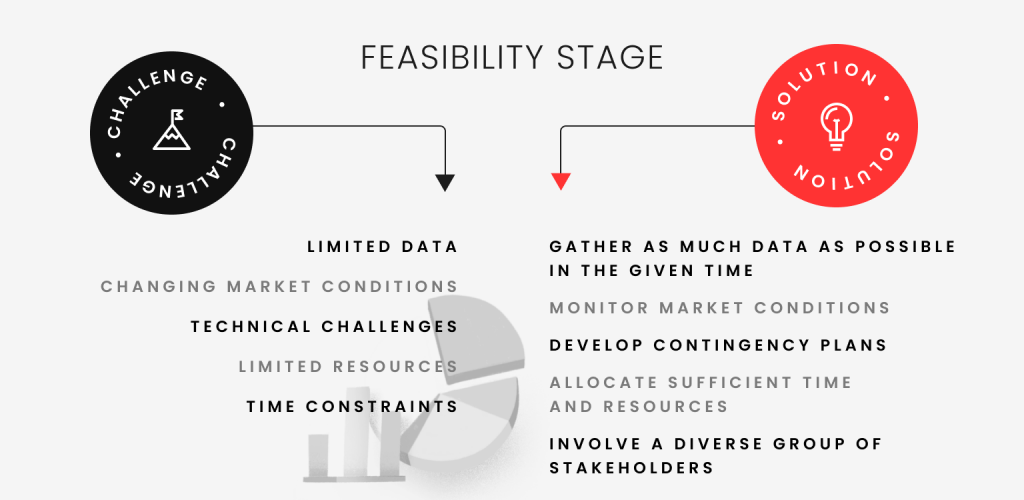
Feasibility analysis involves evaluating the potential of a new product idea to determine if it is worth pursuing. Its goal is to determine the feasibility, or likelihood of success, of a new product idea.
Key Components
- Market analysis. Analyzing the target market for the new product, including the size and potential of the market, the competition, and any potential regulatory or legal issues that may arise.
- Technical analysis. Assessing of the required resources, such as materials, equipment, and personnel, as well as any potential technical challenges that may arise. Check further some tips on how to choose the best tech stack for your development project.
- Financial analysis. Analyzing of the costs involved in developing and producing the product, as well as the potential revenue and profitability of the product. For small and medium businesses, cash flow gap is a real threat. More often than not, companies face cash deficiency way before they can earn any money for their product. You should be a pessimist here, and meticulously count when you can reach the breakeven point. Think at what expense you will cover salaries, mandatory tech and legal payments before that.
Why are we insistent on being pessimist in this case? Because too many factors can play against you.

“The time goes against you and there are cases where you need to reformulate the product, which implies new costs such us legal, marketing, or any other depending on the product that you will launch.”
John Harold Erazo Chamorro, Senior VP, Citi.
- Resource analysis. Evaluating the availability and allocation of resources, including personnel, materials, and equipment, needed to develop and produce the new product.
This stage helps organizations make informed decisions about the allocation of resources and the potential risks and rewards of the project.
Potential Challenges
- Limited data. Often, there is limited data available about the potential market, technical and financial feasibility of a new product. This can make it difficult for organizations to accurately assess the viability of the product, especially if you have small to no experience in the domain. In this case, you can rely on the experience of the outsourcing team.
- Changing market conditions. The market for a new product can change rapidly, which can impact whether the product can be developed and delivered. For example, new competitors may enter the market, or consumer preferences may change.
- Technical challenges. There may be technical challenges associated with developing and producing the new product. Not everything you think of at the ideation stage is possible to realize and commercialize with the current tech.
- Limited resources. Organizations may have limited resources, such as personnel or funding. It is better to see this potential lack at this stage, than to be left shorthanded in the middle of the development process.
- Time constraints. Time limitations can impact the accuracy and completeness of the analysis.
Possible Solutions
- Gather as much data as possible in the given time. This may involve conducting market research, consulting with experts, and analyzing data from similar products or industries.
- Monitor market conditions. Monitor the market closely to stay up-to-date on trends and changes. Keep conducting regular market research and track the competitors’ activities.
- Develop contingency plans. To mitigate the risks associated with technical challenges and limited resources, develop contingency plans that outline alternative courses of action in case these challenges arise.

“Make sure that you have contingency plans in place. Not all data-driven decisions will work out in your favor, so it’s important to make sure that you always have a “fail-safe” in case your decision does not go as planned. By investing time in thinking through the fail-safe and “what-if” decisions, you are removing a bulk of the uncertainty ahead of time.”
Bhargav Sathish, Product Owner at Capital One, Founder at Earth Hacks
- Allocate sufficient time and resources. To overcome time constraints and ensure the accuracy and completeness, engage additional personnel or seeking external expertise as needed.
- Involve a diverse group of stakeholders. To ensure that all relevant perspectives are taken into account, involve a diverse group of stakeholders, including employees from different departments and external experts.
- Pay the utmost attention to the tech stack you choose.
We can assemble a team in 48-72 hours to meet the unique needs of your project.

How to Choose the Best Tech Stack for Your Product Development Project
Projects differ, but most probably you need to think about the following:
- Database, as a place to store information;
- Server-side frameworks to respond HTTP requests;
- A client-side framework for actual client-software interactions.
Obviously, to begin with, you will contemplate what tech stack will cover the product specification and functionality and serve the required functions, speed and performance the best. Here is what else you should keep in mind when choosing a tech stack:
- Scalability. Technology develops fast, but the scalability potential is not equal for all the tech stack options you can choose from. Think about app’s horizontal scalability (can handle more requests) and vertical scalability (adding new resources without damaging performance). Decide, whether a chosen tech stack will allow for a system to handle a considerably higher load without a necessity for redesign.
- Specialist availability. It all comes to money and time you need to hire and change particular specialist in your team. Outsourcing gives you direct access to pre-vetted candidates with a variety of backgrounds, but if you are determined to keep development in-house, focus on a wide-enough pool of specialists.
- License and maintenance costs. You will have to pay annually for the technology you use. Also, you will have to pay for servers, support and updates implementation. Choosing a predominantly open-source products you win financially, but lose in customization, and, sometimes, security. Healthy balance is a key.
QArea experts are united in opinion that it is worth starting on a stack that is quite popular, has good support and distribution. It will be easier to lock the resources and technology will be updated regularly. This is much better than using something “proven” but long-forgotten and creating legacy right away, or experimenting with something promising, but not enough tested yet, that can go off rails any minute.
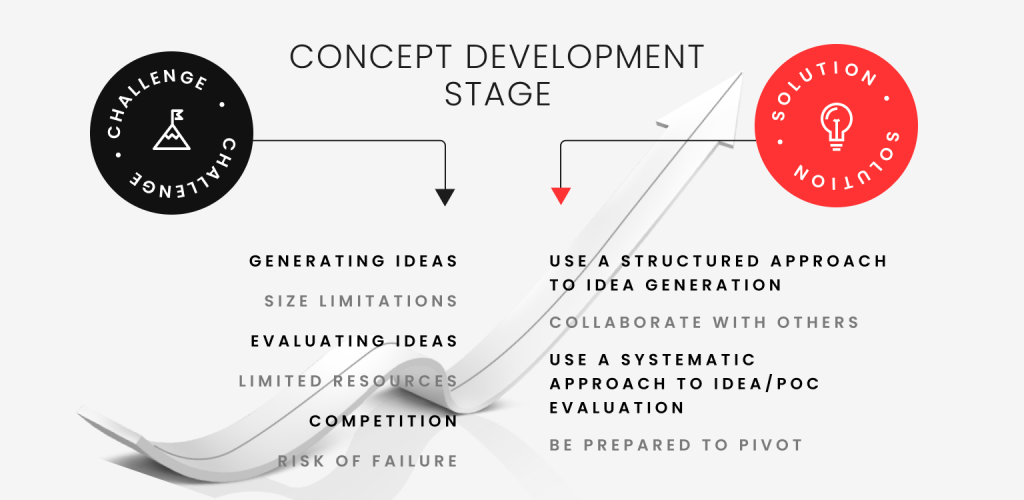
3. Concept Development Stage
Concept development is a stage in the new product development process that involves generating and evaluating ideas for new products or product improvements. It is an important step in the process because it helps to identify potential opportunities for the company to create new products or improve existing ones.
The goal of this stage of these activities is to identify areas where the company can create value for its customers and differentiate itself from its competitors. You need to find both what differs you from others and what matters to customers from those differences. Doing something differently that no one cares about is no go.
After the concept development stage, the company may choose to move forward with one or more of the ideas by conducting further research and development. This may involve prototyping, testing, and refining the product concept before launching it to the market.
Potential Challenges
- Generating ideas. It is a challenging and time-consuming process, as it is difficult for companies to come up with ideas that are both unique and possible to realize.
- Size limitations. Smaller companies have more problems with feasibility, and bigger companies find it hard to think outside the box. Larger companies struggle to adapt to new technologies. Good profits and stability make you a bit blind to what is happening on the market. Startups don’t have that baggage, but at the same time they don’t have enough resilience and resources to test disruptive ideas at the needed scale.
- Evaluating ideas. You need to consider a variety of factors, including market demand and alignment with strategic goals, and both lack of experience and innovative market blindness make it overcomplicated.
- Limited resources. The concept development stage can be resource-intensive, as it involves conducting research, prototyping, and testing.
- Competition. It may be difficult to differentiate a new product idea from those of competitors, and there may be pressure to move quickly to bring the product to market.
- Risk of failure. There is always a risk that a new product idea will not be successful. This risk may be particularly high during the concept development stage, as it is the earliest stage in the development process.
Possible Solutions
- Use a structured approach to idea generation. Use a structured approach, such as brainstorming sessions or design thinking, to generate ideas for new products or product improvements. This can help to ensure that a diverse range of ideas is considered and that the process is systematic and efficient.
- Collaborate with others. Collaborating with other departments within the company, such as research and development or sales and marketing, can help to bring different perspectives and expertise to the concept development process. You can also consider working with external partners, such as customers, suppliers, or academic institutions, to generate and evaluate ideas. When just starting talking about the product (back at the ideation stage), think, which collaborations may help you get the valid concept assessment later.

“The product owner’s job is to absorb all the “I need this done ASAP” demands and prioritize among them, keeping SMEs happy and in line. The trick is giving at least something to everybody as fast as you can so all the SMEs feel included. It is exactly why you need a product owner with pro soft skills!”
Bruce Mason, QArea Delivery and UK director
- Use a systematic approach to idea/PoC evaluation. This can help to ensure that the company is focusing on ideas that have the greatest potential for success.
- Be prepared to pivot. Be ready to modify your product ideas if necessary, based on feedback and additional research.
At this stage, you try to come up with a Proof of Concept, and if you don’t have enough experience with creating and assessing it, it is better to look for the external help. We have seen great ideas lost in attempts to create a viable PoC, and you need an expert product owner to manage this process successfully.
Proof of Concept vs Minimum Viable Product
Proof of Concept (POC) and Minimum Viable Product (MVP) are two terms that are often mixed when talking about product development process. Here is a brief overview of the main differences between POC and MVP:
- Purpose. The primary purpose of a POC is to demonstrate the viability of an idea or concept. This may involve creating a simple prototype or a more fully-featured version of the product, depending on the complexity of the concept. The primary purpose of an MVP is to test the viability of a product with a targeted group of users, in order to gather feedback and validate assumptions about the product.
- Scope. POCs are generally more limited in scope than MVPs, as they are focused on demonstrating the feasibility of a specific concept or idea. MVPs, on the other hand, are more fully-featured products that are intended to be used by a targeted group of users.
- Timeframe. POCs are typically completed in a shorter timeframe than MVPs, as they are focused on a specific aspect of the product and are not intended to be used by a large group of users. MVPs, on the other hand, are typically developed over a longer period of time, as they involve gathering feedback and making iterative improvements based on that feedback.
POCs are used to demonstrate the achievability of a specific idea or concept, while MVPs are used to test the viability of a product with a targeted group of users.
4. Design and Development Stage
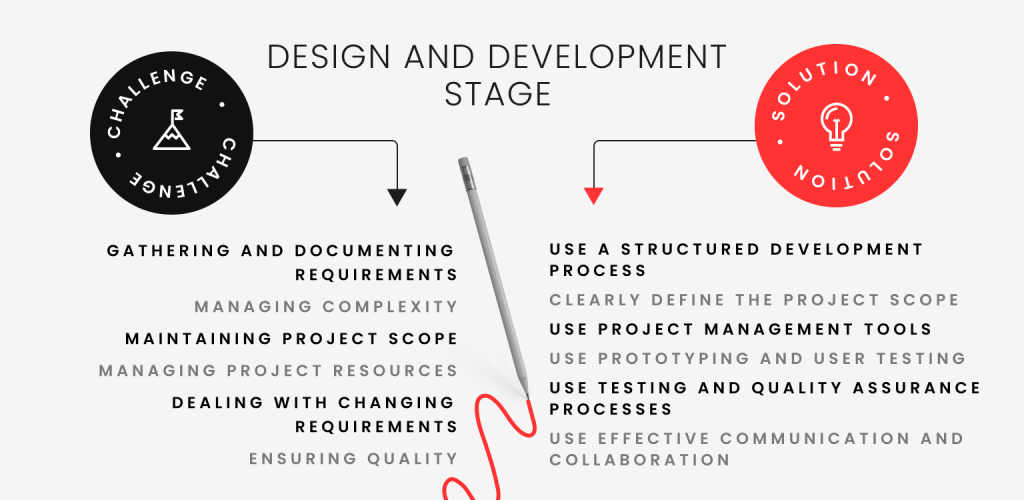
At the design and development stage of the product development process, a company takes a product concept and turns it into a tangible product that is ready for testing and release.
Key Components
- Requirements gathering. Gathering and documenting the functional and non-functional requirements for the software product. This includes determining the desired features and functionality, as well as the target audience and any constraints or limitations.
- Design. Creating a detailed design for the software product, including the user interface, architecture, data models and mockups. May also include prototyping and user testing to validate the design.
- Implementation. Writing the code for the software product based on the design. May include developing individual features or modules, as well as integrating them into a cohesive whole.
Potential Challenges
- Gathering and documenting requirements. Ensuring that all relevant requirements have been gathered and properly documented can be a complex and time-consuming process. It is important to involve stakeholders and users in the requirements gathering process to ensure that the final product meets the needs of all relevant parties.
- Managing complexity. Software development is a complex process, especially for large and feature-rich products. Managing this complexity effectively is critical to the success of the project.
- Maintaining project scope. It is important to ensure that the project stays within its defined scope, as adding new features or functionality can significantly impact the schedule and budget.
- Managing project resources. Ensuring that the project has the necessary resources (e.g., personnel, funding, equipment) is critical to its success. In the changing environment, it is increasingly difficult to predict which and how many resources will be needed.
- Dealing with changing requirements. Changes to requirements can occur throughout the development process, and it is important to handle these changes effectively to avoid project delays and cost overruns.
- Ensuring quality. Ensuring that the final product meets the necessary quality standards is critical to its success. This includes testing the product thoroughly and fixing any issues that are discovered.
A true “no go” strategy at this stage is adding new functions endlessly, conducting new SMEs gatherings, and spending money and time on something that should have been released and earn you money long ago.

“There comes the time when you turn around to acknowledge that you have spent 100 000, a million, two million dollars on product development. What did you actually deliver? If you have developed 80% of your product, does it make sense to deliver the remaining 20%?
It is critical to know when enough is enough. However, businesses may not consider it or just not have enough experience to stop on time. For us, as an outsourcing team, it is ethical to warn clients about potential overheads of prolonging the product development process.”
Possible Solutions
- Use a structured development process. Using a defined development approach, such as Agile product development process or Waterfall, can help to manage complexity and ensure that the project stays on track.
- Clearly define the project scope. Defining the scope of the project at the outset and maintaining tight control over changes to the scope can help to prevent scope creep.
- Use project management tools. Tools such as project management software and issue tracking systems can help to manage project resources and risks.
- Use prototyping and user testing. Prototyping and user testing allow to validate the design of the software product and ensure that it meets the needs of the target audience.
- Use testing and quality assurance processes. Implementing thorough testing and quality assurance processes assists in ensuring that the final product meets the necessary quality standards.
- Use effective communication and collaboration. Good communication and collaboration among all stakeholders, including developers, project managers, product owners, subject-matter experts and users, can help to identify and address any challenges that arise during the development process.

“It is important to involve stakeholders and potential audiences during the early stages of development to get their buy-in later. The best way to do this is by engaging with them throughout the development process and ensuring that their feedback is taken into account. Additionally, having regular meetings where stakeholders can provide input at each stage of the process can help to ensure that their needs and concerns are addressed,”
Benjamin Okyere: Founder, Stress Reliever
5. Testing Stage
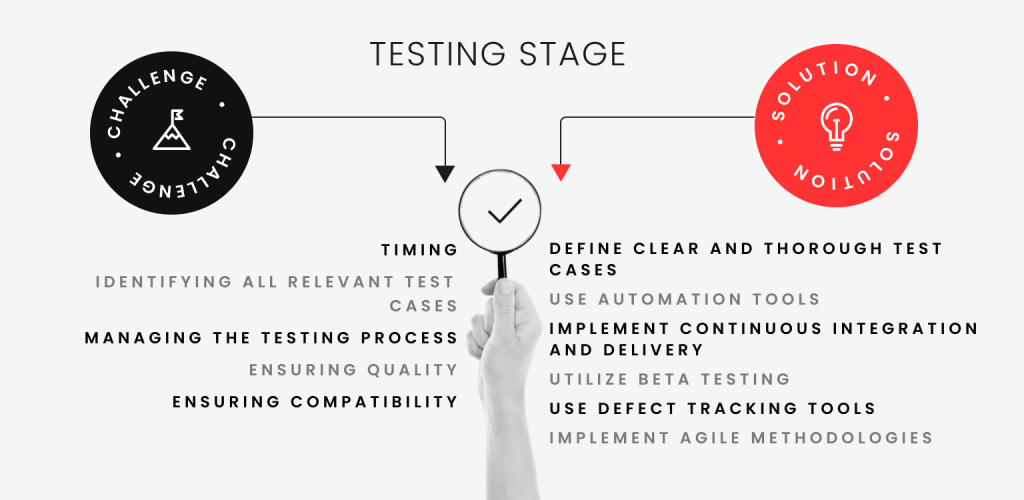
The testing stage of the new software product development process is critical for ensuring the quality and reliability of the final product. During this stage, the software is subjected to a variety of tests to verify that it meets the specified requirements and functions correctly.
Key Components
- Unit testing. Testing individual units or components of the software to ensure that they function correctly.
- Integration testing. Testing how different units or components of the software work together as a cohesive whole.
- Acceptance testing. Testing the software to ensure that it meets the specified requirements and is ready for release. May include testing by users or stakeholders to ensure that the software is user-friendly and meets their needs.
- Performance testing. Testing the product to ensure that it performs as expected under a variety of conditions, including high load or stress.
- Security testing. Testing the app to ensure that it is secure and resistant to attacks.
- Regression testing. Retesting the software after changes have been made to ensure that the changes have not introduced any new defects.
Potential Challenges
- Timing. Testing and QA efficiency highly depends on when you start testing and how wide you spread a QA net. For financial and organizational reasons, companies push testing closer to the end of the development process, and it often backfires.

“Involving QA at the earliest possible stage allows you to make sure not only that the product works as planned, but also that the idea itself works and meets the expectations of the audience. This way, you make adjustments and avoid costly rework or even product failure.”
- Identifying all relevant test cases. It can be difficult to identify all relevant test cases and ensure that the software is tested thoroughly enough.
- Managing the testing process. The testing process can be complex and time-consuming, and it is important to manage it effectively, timely dealing with all the bottlenecks.
- Ensuring quality. Ensuring that the final product meets the necessary quality standards is critical to its success. This includes testing the product thoroughly and fixing any issues that are discovered.
- Ensuring compatibility. It is important to ensure that the software is compatible with the intended operating systems, devices, and other software. Testing for compatibility can be a complex and time-consuming process that requires access to many physical devices, including flagman iOS and Android gadgets.
Possible Solutions
- Define clear and thorough test cases. It is important to define clear and thorough test cases that cover all the features and functionality of the software. This will help ensure that all the relevant aspects of the software are tested and that any issues are identified and addressed.
- Use automation tools. Automation tools can help to speed up the testing process by automating repetitive tasks and allowing testers to focus on more complex areas of the software. Automation allows you to make glitch-free releases up to 80% faster.
- Implement continuous integration and delivery. Continuous integration and delivery (CI/CD) practices can help to ensure that new code is tested and deployed quickly and efficiently, without delays.
- Utilize beta testing. It involves releasing the software to a group of users for testing purposes before it is released to the public. This can help to identify any issues and gather valuable feedback from real users.
- Use defect tracking tools. Defect tracking tools allow testers to identify, track, and resolve defects in the software. These tools can help to streamline the testing process and improve the overall quality of the software.
- Implement agile methodologies. Agile development methodologies, such as Scrum, can help to ensure that testing is an ongoing process throughout the development lifecycle, rather than a separate phase at the end. This can help to identify and resolve issues earlier in the process, resulting in a higher quality end product.
QA and testing are a whole separate system that should be managed and executed by professionals. Don’t overwhelm your team with fractions of testing duties, that won’t be efficient anyway — consider outsourcing the whole gig to an expert company like ours.
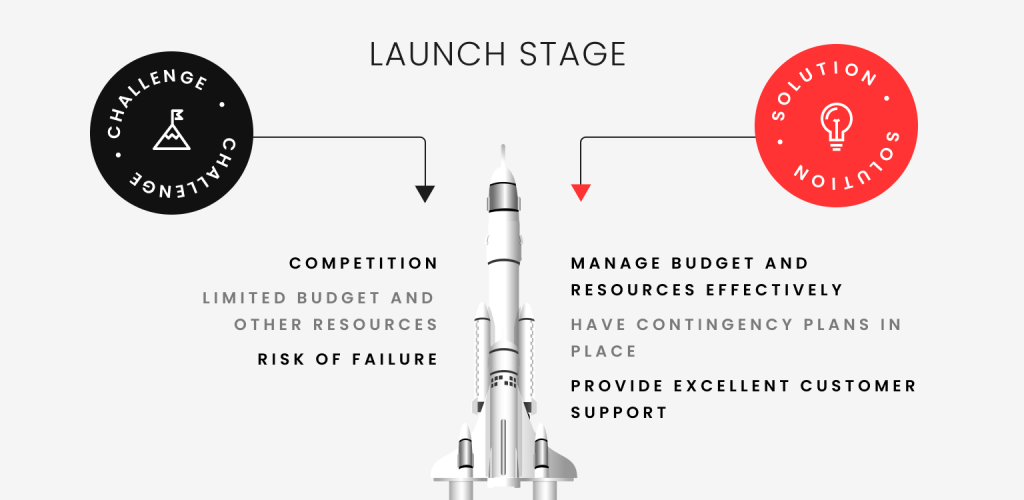
6. Launch Stage
Key components
- Developing a marketing plan. Creating a plan for promoting and selling the product, including identifying the target market, setting pricing, and developing a marketing strategy.
- Setting up distribution channels. Establishing the channels through which the product will be made available to customers, adapting to web app and mobile app stores policies, etc.
Launching the product. Making the product available to the public and promoting it through marketing and sales efforts.
“I have seen an eCommerce-based system that went live and neither attracted much attention, nor got enough feedback because the client didn’t send an e-mail to their waitlist. They did lots of PR, but forgot to tell their customers they were launching. It always comes back to planning and checking — and I recommend triple checks in such cases.”
Bruce Mason, QArea Delivery and UK director
- Providing customer support and gathering feedback. It’s important to have a system in place to provide support to customers and receive continuous feedback that will be used to improve your product later.
Potential Challenges
- Competition. The market develops fast and when you’re ready to launch, you may find out that there are other products similar to or competing with your new product. And you didn’t anticipate them before, because they were at the development stage, just like yours.
- Limited budget and other resources. Launching a new product can be costly, and there may be a limited budget available to support the launch. It’s important to carefully manage resources and prioritize efforts to ensure that the launch is successful.
- Risk of failure. There is always a risk that a new product will not be successful in the market, despite the best efforts of the company. It’s important to have contingency plans in place to mitigate this risk and minimize the impact of any potential failure.
Possible Solutions
- Manage budget and resources effectively. Set clear goals and priorities, negotiating with suppliers, and looking for cost-effective solutions. We recommend planning resources from a “glass half empty” standpoint, and remember that most companies have to increase the budget 30% in the product development process.
- Have contingency plans in place. Contingency plans help to mitigate the risk of failure and minimize the impact of any potential setbacks. This may involve having alternative marketing and distribution strategies, or identifying potential partners or investors.
- Provide excellent customer support. It’s important to have a system in place to provide support to customers and address any issues or concerns they may have. This can help to build trust and loyalty, and improve the chances of success for the product.
7. Maintenance and Improvement Stage
The maintenance and improvement stage of the new product development process is the ongoing process of maintaining and improving a product after it has been launched. This stage is important because it helps to ensure that the product continues to meet the needs and expectations of the target audience and remains competitive in the market.
Key components
- Providing customer support. This may involve a customer service hotline, online support portal, or other channels for customer communication.
- Gathering customer feedback. Gathering feedback from customers to understand their needs and preferences, and to identify any potential issues or areas for improvement with the product.
- Making improvements. Updating the product to keep it relevant and competitive. This may involve adding new features, making design changes, or updating the product to meet new standards or regulations.
- Maintaining the product. It’s important to maintain the product to ensure that it continues to function properly and meet the needs of the target audience. This may involve performing regular maintenance, providing updates or patches, fixing bugs, etc.

“It’s important to focus on improving your existing products and features before shifting your focus to developing new products, as this helps build loyalty with your customers and fuels recommendations and referrals. Making meaningful changes to improve product features or adding features that are highly requested by existing customers are two great ways to increase customer satisfaction and attract new customers.”
Melody Shiue, Co-Founder, Director; Chief Design Officer at Bodymapp
Potential Challenges
- Maintaining and updating the software. As technology and users evolve, it is important to maintain and update the software to ensure that it remains relevant and effective.
- Managing user feedback and requests. It is important to consider and address user feedback and requests for new features or improvements to the software. Balancing these requests with the available resources and priorities can be challenging.
- Ensuring compatibility with new technologies. As new technologies emerge, it may be necessary to update the software to ensure compatibility and take advantage of new capabilities.
- Managing technical debt. Technical debt refers to the accumulation of shortcuts, workarounds, and other quick fixes that may have been implemented during the development process.
- Ensuring security and data privacy. It is important to ensure that the software is secure and that user data is protected. This can be challenging, as new security threats and vulnerabilities emerge continuously over time.
- Managing resources and budgets. Maintaining and improving the software can be expensive, and it is important to manage resources and budgets in a balanced way to ensure that the software remains viable and successful.
Possible Solutions
For challenges at the maintenance and improvement stage repeating challenges from previous stages of the product development process, you can use the solutions mentioned above to deal with most common issues.
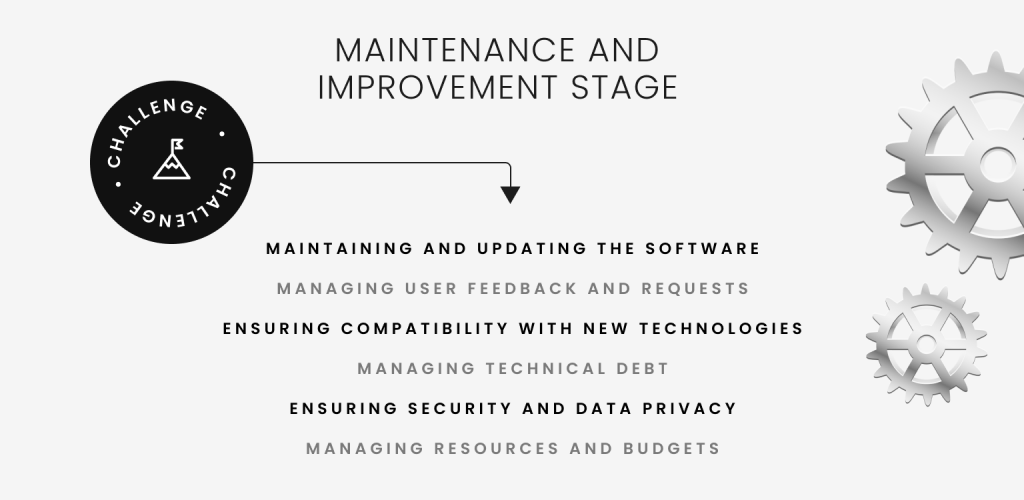
Why Product Development Process Is Important
Even if you haven’t fully read all the challenges of all the product development phases, you have most probably understood that it is an excruciatingly difficult process that requires lots of attention, money and time investment, and, to some extent, some luck. Why would you go into all this trouble? Are there shortcuts? Why is product development process important, and what are the reasons to actually follow it meticulously?
Reason #1. Helps to ensure that the project stays on track. A well-defined development process keeps the project on course and ensures that all necessary tasks are completed in a timely manner. This can help to prevent delays and ensure that the product is delivered on schedule.
Reason #2. Increases the chances of success. A well-defined process helps to ensure that all necessary tasks are completed, that the product meets the needs and expectations of the target audience, and that any potential issues or challenges are addressed in a timely manner.
Reason #3. Improves communication and collaboration. Helps to improve communication and collaboration among team members, as it provides a clear framework for how tasks should be completed and who is responsible for each task. This can help to reduce confusion and ensure that all team members are working towards a common goal.
Reason #4. Facilitates decision-making. A defined development process can help to facilitate decision-making by providing a clear set of guidelines and criteria to follow. This can help to ensure that decisions are made in a consistent and logical manner and that the project stays on track.
Now, when you are convinced that you need to do it following a particular process, let us tell you, how to manage it for maximum efficiency and minimal time and money loss.
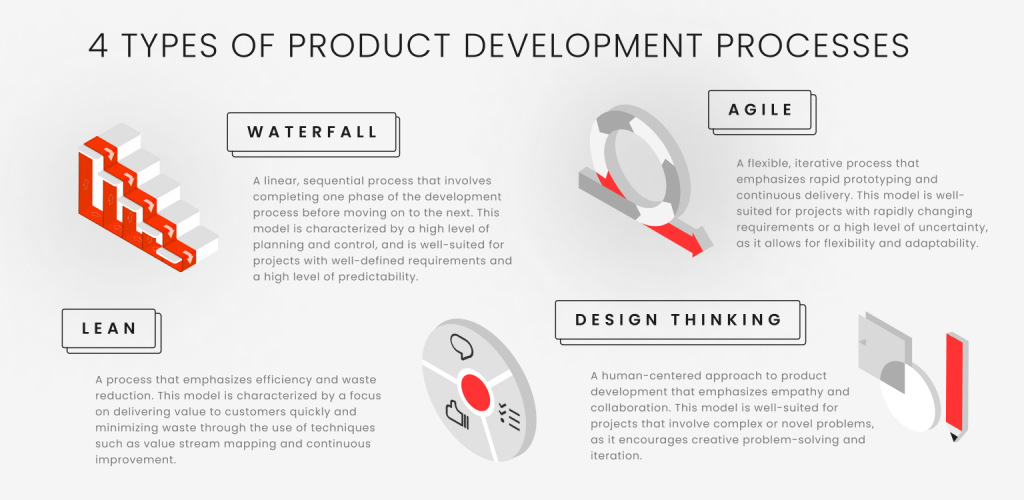
What are the 4 types of product development processes
There are several different types of product development processes that organizations may use, depending on their needs and goals. Some common types of product development processes include:
Type #1. Waterfall. A linear, sequential process that involves completing one phase of the development process before moving on to the next. This model is characterized by a high level of planning and control, and is well-suited for projects with well-defined requirements and a high level of predictability.
Type #2. Agile. A flexible, iterative process that emphasizes rapid prototyping and continuous delivery. This model is well-suited for projects with rapidly changing requirements or a high level of uncertainty, as it allows for flexibility and adaptability.
Type #3. Lean. A process that emphasizes efficiency and waste reduction. This model is characterized by a focus on delivering value to customers quickly and minimizing waste through the use of techniques such as value stream mapping and continuous improvement.
Type #4. Design thinking. A human-centered approach to product development that emphasizes empathy and collaboration. This model is well-suited for projects that involve complex or novel problems, as it encourages creative problem-solving and iteration.
Benefits of Outsourcing One or More of Product Development Phases
No matter how many great articles you read, the big part of the product development process will stay a black box for you if you don’t have years of experience in software development, QA, support, etc. And here is why outsourcing the entire process of some of its stages may be a good idea:
Benefit #1. Time savings. Outsourcing the product development process can save organizations time, as it allows them to access a team of developers who can work on the project full-time. According to a survey by Deloitte, 41% of organizations reported time savings as a key benefit of outsourcing.
Benefit #2. Cost savings. Outsourcing may be more cost-effective than hiring an in-house team, especially for small or medium-sized organizations. This is because outsourcing companies often have lower overhead costs and can offer competitive rates for services on various product development phases.
Benefit #3. A way to improve quality. Outsourcing companies often have established agile product development process and quality control measures in place to ensure that the software they deliver meets the required standards.
Benefit #4. Greater scalability. Outsourcing product design process allows you to quickly add or remove development resources as needed. More than 46% of respondents of Deloitte survey report looking for fast scalability as a key outsourcing benefit.
Benefit #5. Enhanced innovation. Reaching out to specialists outside your company help to tap into new ideas and approaches that you may not have considered internally.
Benefit #6. Improved focus. By outsourcing software development, you can focus on your core competencies and business operations, rather than having to manage the development process themselves. This can help to improve efficiency and productivity.
This is the most we have ever written on new product development, and we hope that you have received a good enough understanding of the process to assess your situation and be ready to challenges that will emerge no matter what. If you want to know how much it may cost to delegate these challenges to our domain and tech experts, ask for a quick estimate here. If you want to continue your dive into this topic, before you make any decision, here are some reads you may find useful:
Product Management
- Product Mindset vs Project Mindset: Mentality Shift for Startups
- Bruce Mason on Product Development Process: “You need to know when enough is enough.”
- 7 Stages of Software Development Cycle (with Tools and Techniques for every stage)
Domain-specific knowledge base
- Healthcare CRM Software: Peculiarities of Making a Good One
- eCommerce Trend Report: The State Of The Industry In 2022
- A Short Guide to Project Cost Estimation in Software Development Outsourcing
Product development outsourcing
- Recent Changes in the New Product Development Process
- Seven Steps In Product Development Process
- Why Product Development Process Is Important
- What are the 4 types of product development processes
- Benefits of Outsourcing One or More of Product Development Phases
Planning to improve development process?
Decrease the entropy of product design and development, and increase your chances of success.
Written by

Hire a team
Let us assemble a dream team of specialists just for you. Our model allows you to maximize the efficiency of your team.
We Help With
Your tech partner needs to be well versed in all kinds of software-related services. As the software development process involves different stages and cycles, the most natural solution is to have them all performed by the same team of experts. That’s exactly what our diverse range of services is for.
The choice of technology for your software project is one of the defining factors of its success. Here at QArea, we have hands-on experience with dozens of popular front-end, back-end, and mobile technologies for creating robust software solutions.
In-depth familiarity and practical experience with key technologies are one of the cornerstones of successful software development and QA. But it also takes specific knowledge of the industry to develop a solution that meets the expectations of the stakeholders and propels its owner to success.

Ensure an effective online presence for your business with a corporate site.


























